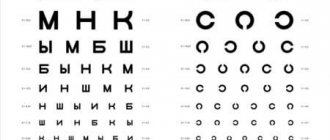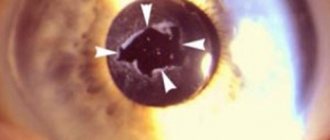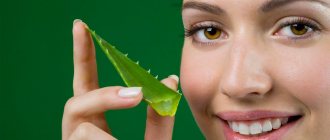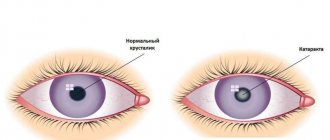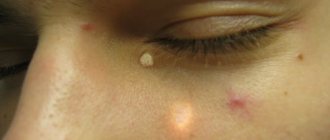Diet and lifestyle influence the development and progression of glaucoma by helping to control intraocular pressure (IOP) and maintaining overall visual health.
Because glaucoma is not a curable disease and any visual damage caused by it cannot be reversed, prevention for those at risk and slowing progression for those diagnosed with glaucoma are vital components of treatment.
Research shows that certain nutrients are more effective than others in protecting the eyes and reducing the risk of diseases such as glaucoma. A healthy diet does not replace treatment, however, a balanced diet helps maintain vision and prevent its rapid deterioration.
Why follow a diet for glaucoma
Maintaining blood circulation in glaucoma is important. A balanced diet provides the retina with beneficial nutrients. Vitamins, minerals and other macro- and microelements maintain vascular tone and prevent the problem from worsening.
Benefits of the diet:
- improvement of trophism;
- slowing down the progression of the disease;
- restoration of metabolism in eye tissues;
- prevention of damage to retinal cells.
There have been no conclusive studies to show that taking vitamins or supplements can cure glaucoma.
We recommend reading: How to treat glaucoma at home
The development of the disease is associated with increased pressure in the eye. Eye drops and surgery are the most effective ways to lower blood pressure and prevent future damage.
However, there is a link between dietary intake of nitrate-rich green leafy vegetables and the development of glaucoma. The study, which followed men and women over 25 years, found that those who ate more green leafy vegetables such as lettuce, kale and spinach had a lower risk of being diagnosed with glaucoma.
The theory is that nitrates can improve blood flow to the eye and also reduce eye pressure.
A little about the disease
Glaucoma is an ophthalmological disease, the main manifestation is a persistent increase in intraocular pressure. Gradual atrophy of the optic nerve leads to damage or loss of function of the eye, including blindness. The level of development of medicine still does not allow to cure the disease completely, but it can keep its development under control.
Causes
In a healthy eye, there is a constant flow and flow of fluid. If there is a discrepancy between the volume of fluid produced and drained, the pressure inside the eye increases. As a result of its action, the nerve at the back of the eye is damaged. Due to atrophy of the optic nerve, visual signals stop reaching the brain and the person loses the ability to see.
Kinds
Open angle . Violation of the function of the natural drainage system, although access to moisture is open. The visual field narrows over several years; this process occurs unnoticed and painlessly. Patients find it difficult to answer the question about the presence of complaints.
Closed angle . The intraocular fluid does not have access to the drainage system due to the iris blocking the angle of the anterior chamber. The pressure inside the eye increases quickly and an acute attack of glaucoma occurs, which can lead to sudden loss of vision.
Symptoms
A serious excuse for visiting an ophthalmologist is the appearance of complaints:
- Black spots or veils before the eyes;
- Deterioration of lateral vision and image distortion;
- Pain in the eye sockets;
- Blurred vision at dusk, in the evening, at night;
- Redness of the sclera;
- Decreased vision;
- Dark spots in the field of vision.
Sharp pain in the eye and obvious visual impairment, the appearance of rainbow circles when looking at a light source, swelling and redness, nausea and vomiting are symptoms of an acute attack; you should consult a doctor immediately.
Vitamins
Essential vitamins for glaucoma:
- Vitamin B - peanuts, egg yolk, walnuts, cheese, brown rice, leafy vegetables, buckwheat, whole grain bread.
- Zinc - oranges, currants, rice, beans, potatoes, ginger, squid, meat, beets.
- Omega 3 - tuna, salmon, trout, mackerel, nuts.
- Vitamin C - broccoli, orange, lemon, onion, tomato, potato.
- Tocopherol - corn, sunflower and soybean oil. Contained in hazelnuts and walnuts, sunflower seeds.
- Vitamin A - peach, melon, cod liver, milk, eggs, butter.
- Vitamin P - blackberries, lettuce, tomatoes, rowan and black currants.
Proper nutrition for patients with glaucoma
Recommended:
- lean meats and fish (preferably boiled);
- sausages (doctor’s type);
- soy products (meat substitutes);
- milk and lactic acid products (yogurt, yogurt, biokefir, etc.);
- low-fat cottage cheese and cheeses;
- cereals - oatmeal, buckwheat, millet;
- vegetable, vegetarian soups, low-fat meat soup 1-2 times a week;
- black and white bread, no more than 200 g per day;
- vegetables (cabbage, cucumbers, tomatoes, zucchini, pumpkin) in moderation;
- fruits;
- legumes (beans, beans, peas).
It is advisable to limit:
- easily digestible carbohydrates (sugar, jam, sweets, honey);
- butter, sour cream;
- at least 30% of all fats should be vegetable fats;
- fluid intake (no more than 1500 ml).
Exclude:
- strong tea, strong coffee;
- baked goods;
- spices;
- concentrated meat and fish broths;
- salted and soaked foods;
- meat by-products (kidneys, liver, lungs);
Remember, systematic alcohol consumption in patients with glaucoma
strictly contraindicated!
Recommended Products
To reduce the risk of developing glaucoma, be sure to follow a balanced diet that includes the following tasty and healthy foods:
- Salmon, sardines and halibut are rich in omega-3 fatty acids. Research shows that omega-3 fatty acids improve blood flow, lower blood pressure and intraocular pressure.
- Fruits and vegetables such as oranges, peaches, greens and cabbage. Data from the Rotterdam study show that women aged 55 years and older who ate 3 or more servings of fruits and vegetables high in vitamins A, C and carotenoids each day had a 79% lower risk of developing glaucoma compared to study subjects who did not ate the same amount of fruits and vegetables.
- Whole grain breads and cereals that are high in thiamine.
- Dark chocolate. If you needed another reason to treat yourself to a piece of dark chocolate today, here's one. An intriguing 2021 study published in JAMA Ophthalmology found that adults who ate a dark chocolate bar saw better—enjoying improvements in vision clarity and contrast sensitivity—about two hours afterward, possibly due to increased blood flow. Even if the bar doesn't improve vision, the flavonoids found in dark chocolate may help improve vision in people with glaucoma, as well as reduce the risk of macular degeneration. But use it in moderation, otherwise other health problems will appear.
- Spinach and other dark green leaves such as kale and collard greens contain two antioxidants, lutein and zeaxanthin, which are stored in the macula of the eye, which helps protect the eye from harmful light. Helps maintain blood flow in the eyes.
- Eggs. The study found that eating just one egg per day for 5 weeks increased lutein levels by 26% and zeaxanthin levels by 38% (the study also found that this daily egg-a-day intake had no negative impact on cholesterol or triglyceride levels) . Egg yolks are also a rich source of vitamin D, which may also help protect against macular degeneration.
- Seafood. Oysters are the best source of the mineral zinc. Zinc helps vitamin A create melanin, a pigment that protects the eyes. Deficiency can cause poor night vision or night blindness, as well as cataracts and glaucoma. In high doses, zinc slows the progression of macular degeneration and glaucoma if the disease is early stage.
- Hot tea. People who drink hot tea every day are 74% less likely to develop glaucoma.
- Sunflower seeds. A Spanish study of about 600 men and women aged 65 and older found that people who ate a healthy diet providing at least 8 milligrams of vitamin E per day had significantly lower rates of disease.
Other recommended foods that are good for eye health include:
- cucumbers;
- green peas, beans, olives;
- celery;
- avocado;
- carrot;
- cheese;
- pumpkin;
- tomatoes;
- corn;
- nuts;
- whole grains and cereals;
- milk;
- green tea.
We recommend reading: What not to do with glaucoma
Beta carotene
One of the strongest antioxidants is beta-carotene. It is known that a deficiency of this substance can lead not only to cataracts, but also to “night blindness,” chronic blepharitis and xerophthalmia. Moreover, just one single molecule of beta-carotene can neutralize a thousand molecules of free radicals.
The following foods contain the most beta-carotene:
- carrot;
- parsley;
- turnip;
- cabbage;
- apricots;
- bell pepper (red);
- watermelons;
- egg yolk;
- butter;
- sour cream;
- liver.
These products help prevent the development of ophthalmic pathologies and therefore should be included in the diet. This primarily applies to people at risk for cataracts.
Finally, we would like to remind you that no diet, unfortunately, will allow you to restore transparency to an already clouded lens. The most effective method of treating cataracts is surgery - phacoemulsification with the installation of an intraocular lens. You can undergo cataract treatment in Moscow at our OkoMed clinic. We have high-level specialists who will definitely help you cope with the disease.
Menu for a week for glaucoma
Table. Diet for 7 days.
| Days of the week | Breakfast | Snack | Dinner | Dinner |
| Mon | oatmeal; steamed vegetables; green tea. | fermented baked milk; berries. | chicken soup; vegetable salad; steamed cutlets. | stewed veal with vegetables; low-fat cottage cheese; carrot juice. |
| VT | cottage cheese; Black tea. | apple. | chicken stew; herbal decoction; low-fat yogurt. | Cod liver; cucumber and tomato; buckwheat porridge. |
| SR | two eggs; kefir; cheese. | a cup of blueberries; milk. | steamed vegetable mix; light lentil soup. | rice porrige; vegetable salad; cheese; piece of dark chocolate. |
| Thu | cottage cheese with orange; banana pancakes; tea. | grapefruit. | baked chicken fillet; whole wheat bread; light chicken soup. | fruit salad; a piece of cheese with butter; green tea. |
| PT | oatmeal with fruit; milk. | fruit salad with condensed milk. | vegetable stew; a piece of bread; dark chocolate. | cottage cheese; low-fat kefir. |
| SB | a glass of kefir; black bread with a slice of cheese. | orange and apple or fresh vegetables. | pea soup; whole wheat bread; cucumber. | steamed vegetables; boiled chicken breast; fruit jelly. |
| Sun | Same as on Wednesday. | |||
What can you eat and drink?
List of food products:
- lettuce, spinach, dill, parsley;
- buckwheat, oatmeal;
- walnuts;
- olive oil;
- lean fish;
- fruits: grapes, apples, apricots;
- green tea;
- cottage cheese;
- unsalted cheese;
- lean meat;
- pasta;
- any berries;
- milk, kefir;
- citrus fruits: oranges, lemons;
- legumes;
- vegetables: zucchini, cabbage, beets, carrots.
The first step to improving or partially restoring vision is to switch to natural products that undergo minimal heat treatment. Refined foods and sophisticated dishes are high in calories and at the same time poor in minerals.
- The presence of fresh vegetables and fruits and herbs on the table in the autumn-summer period is welcome. They contain vitamins and minerals that have anti-inflammatory and antioxidant effects. Their stable, but also moderate consumption is important. If a quarter of the volume of vegetables is added raw to the cooked ones, then the loss of vitamin C is compensated. Fresh vegetables should be more chopped. All varieties of cabbage, spinach, kohlrabi, carrots, celery are suitable;
- Cereals, which are better to be steamed than to be cooked for a long time in boiling water, are not prohibited. Oatmeal, buckwheat and wheat are suitable;
- It is necessary to include meat in the diet, but low-fat varieties: turkey, chicken breast, baked or boiled rabbit;
- Fish and seafood contain polyunsaturated fatty acids. You can only eat fish made from fresh or frozen raw materials, not canned or smoked. Low-fat varieties - cod, pike perch, pike;
- Pasta can be eaten in moderation by choosing durum wheat;
- You can eat fresh berries in combination with dairy products. Blueberries, blueberries, raspberries, strawberries are useful;
- Eggs can be eaten no more than three times a week, preferably boiled, or as part of other dishes.
Undesirable and prohibited foods for cataracts and glaucoma
For glaucoma and cataracts, first of all, it is necessary to exclude from the diet foods that provoke an increase in blood pressure. The following products are considered the most harmful:
- alcohol,
- fresh bakery,
- fatty broths from meat and fish,
- coffee and strong tea,
- spices and hot spices,
- pickles.
If necessary, coffee can be replaced with chicory, and tea can be consumed in low concentration. Instead of fresh baked goods, which contain carbohydrates that are difficult to digest, you can eat bran.



